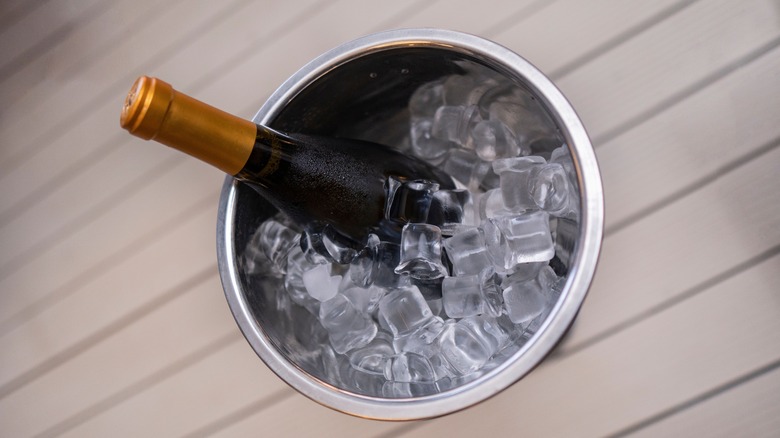Turns Out You're Adding Ice To Your Wine Bucket All Wrong
While different wines are best at different temperatures, no wine is truly enjoyable when it's as warm as room temperature. Whether you need to chill a bottle that's gotten too warm before you serve it or you want to keep the bottle from getting too warm over the course of a dinner, a bucket of ice can be the easiest and most effective strategy — if you're doing it right, that is.
It sounds so simple, but in reality, it's something many of us do without even thinking: We fill a bucket with ice and then we stick the bottle in. That, as it turns out, is backwards. The bottle is never going to get as fully submerged as it needs to be to actually start chilling down. If you put the wine in the bucket first, though, and then fill all of the remaining space with ice and cold water, the bottle is enveloped in coldness that will start to work its magic.
To make your ice bucket extra efficient, follow Ina Garten's fast wine-cooling advice. Make sure the bottle is covered up to its neck in ice and water, and then, as a fan of hers pointed out, you can even add some salt to speed up the chilling action. Pouring in two cups of salt can get your wine down to 45 degrees Fahrenheit in just five minutes. The temperature drop happens faster still if you move the bottle a bit every few minutes.
Getting your wine down to the ideal temperatures
While you never want wine that's too warm, you also don't want wine that's ice-cold. When temperatures are too low, the flavor and aroma compounds in the wine aren't as active, meaning you don't get as much flavor. So, it's handy to know a few ideal temperatures for different types of wine. When you first start chilling different wines with your new-and-improved ice bucket technique, use a probe thermometer to track the wine's temperature and see how fast it drops; that way, going forward, you know just about how many minutes different wines need to get chilled but not freezing.
Most sparkling wines should be the coldest, between 40 and 50 degrees Fahrenheit. White wines and rosés are best between 45 and 55 degrees, and between 55 and 60 degrees is ideal for orange wines and lighter-bodied red wines. For reds more medium to fuller-bodied, the range tops out at 60 to 65 degrees. To plan ahead and serve wines at their best, store types that should be colder in your fridge right when you bring them home, while reds can just go into the refrigerator about an hour before enjoying. Most types alternatively benefit from 30 minutes in the freezer. In a pinch, however, and always when you want to maintain chilled temperatures, say, outside, or for a party, the ice bucket is your best friend. Just make sure the bottle goes in first.

